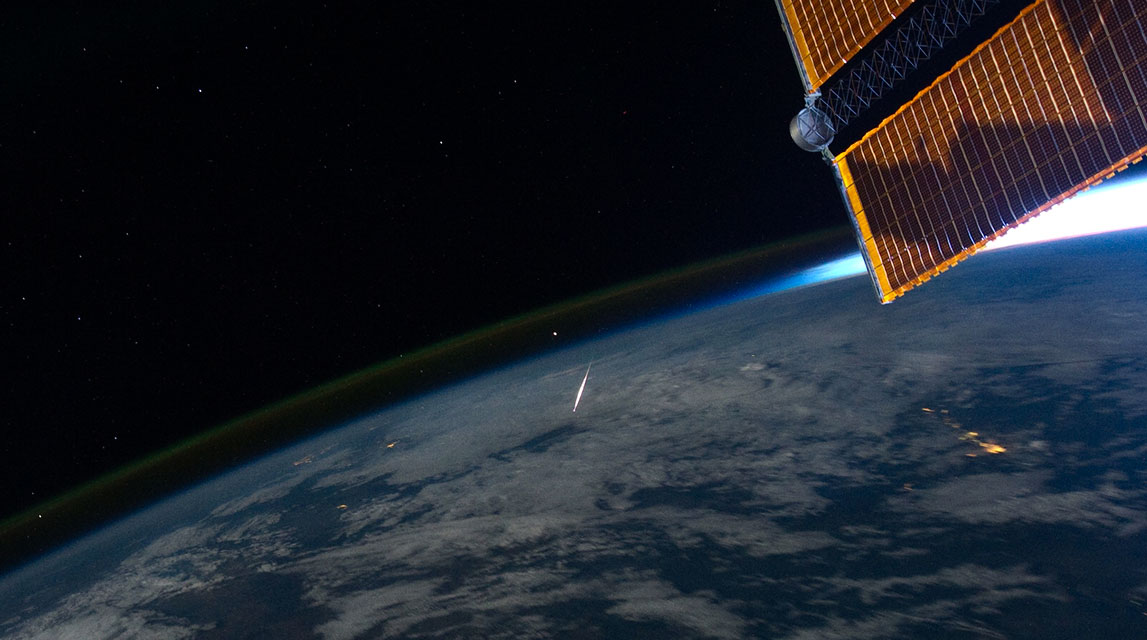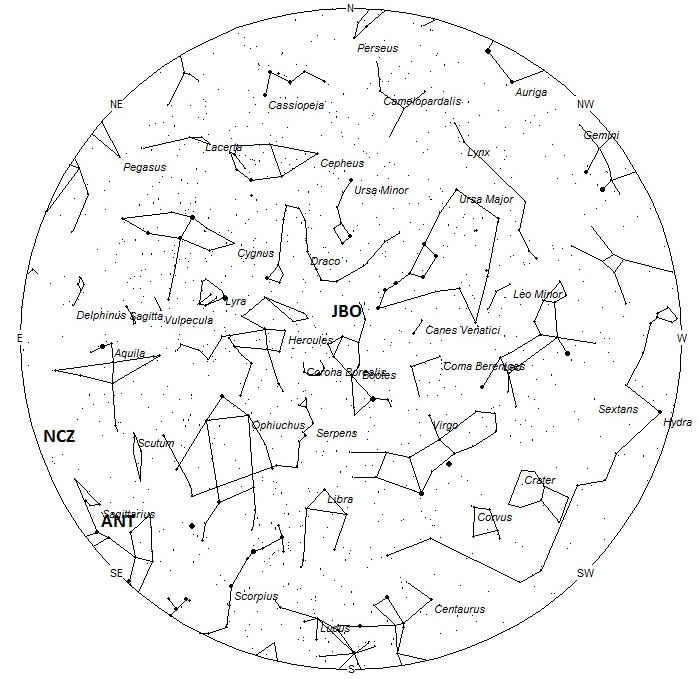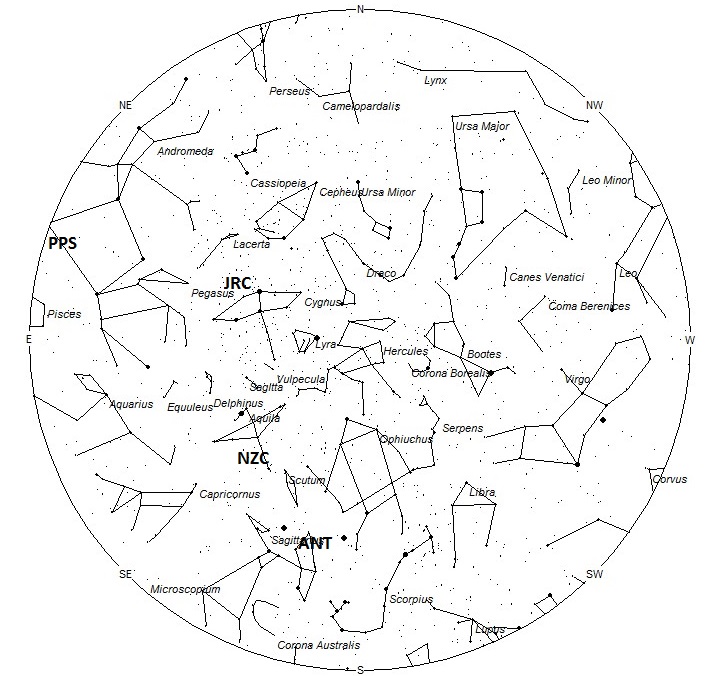
During this period the moon will reach its last quarter phase on Saturday June 17. At this time the half-illuminated moon will rise near 0100 for most observers located at mid-northern latitudes. While these conditions are not perfect, one can still obtain good meteor viewing results simply by viewing in a direction so that the moon lies out of your field of view. Conditions improve with each passing night as the moon wanes and rises later and later. The estimated total hourly meteor rates for evening observers this week is near 2 for those viewing from the northern hemisphere and 3 for those located south of the equator. For morning observers the estimated total hourly rates should be near 7 as seen from mid-northern latitudes (45N) and 10 as seen from tropical southern locations (25S). The actual rates will also depend on factors such as personal light and motion perception, local weather conditions, alertness and experience in watching meteor activity. Morning rates during this period are reduced due to moonlight. Note that the hourly rates listed below are estimates as viewed from dark sky sites away from urban light sources. Observers viewing from urban areas will see less activity as only the brightest meteors will be visible from such locations.
The radiant (the area of the sky where meteors appear to shoot from) positions and rates listed below are exact for Saturday night/Sunday morning June 17/18. These positions do not change greatly day to day so the listed coordinates may be used during this entire period. Most star atlases (available at science stores and planetariums) will provide maps with grid lines of the celestial coordinates so that you may find out exactly where these positions are located in the sky. A planisphere or computer planetarium program is also useful in showing the sky at any time of night on any date of the year. Activity from each radiant is best seen when it is positioned highest in the sky, either due north or south along the meridian, depending on your latitude. It must be remembered that meteor activity is rarely seen at the radiant position. Rather they shoot outwards from the radiant so it is best to center your field of view so that the radiant lies at the edge and not the center. Viewing there will allow you to easily trace the path of each meteor back to the radiant (if it is a shower member) or in another direction if it is a sporadic. Meteor activity is not seen from radiants that are located far below the horizon. The positions below are listed in a west to east manner in order of right ascension (celestial longitude). The positions listed first are located further west therefore are accessible earlier in the night while those listed further down the list rise later in the night.
These sources of meteoric activity are expected to be active this week.
.
The June Bootids (JBO) are usually a very weak shower that occasionally produces outbursts. Nothing out of the ordinary is expected this year. These meteors are best seen from June 23-25 with maximum activity occurring on the 24th. At maximum the radiant is located at 14:58 (224) +48. This position lies in northwestern Bootes, 15 degrees east of the second magnitude star known as Alkaid (Eta Ursae Majoris). This radiant is best placed in the evening sky just as the sky becomes dark. Observers in the northern hemisphere have a distinct advantage over those located south of the equator as the radiant lies much higher in the evening sky. No matter your location, little activity is expected from this source. With an entry velocity of 18 km/sec., the average June Bootid meteor would be of very slow velocity.
The center of the large Anthelion (ANT) radiant is currently located at 18:36 (279) -23. This position lies in northern Sagittarius, 3 degrees north of the 3rd magnitude star known as Kaus Borealis (lambda Sagittarii). Due to the large size of this radiant, Anthelion activity may also appear from the nearby constellations of Scutum and southeastern Ophiuchus as well as southern Ophiuchus . This radiant is best placed near 0200 local summer time (LST), when it lies on the meridian and is located highest in the sky. Hourly rates at this time should be near 2 as seen from mid-northern latitudes and 3 as seen from tropical southern latitudes. With an entry velocity of 30 km/sec., the average Anthelion meteor would be of slow velocity.
The Northern June Aquilids (NCZ) were also discovered by Zdenek Sekanina. These meteors are active from June 5-July 22, with maximum activity occurring on the July 3. The current position of the radiant is 19:44 (296) -09. This position lies in a remote area of southern Aquila directly between the easily recognizable stars Algiedi (Alpha Capricorni) and Al Thalimain (lambda Aquilae). Current rates are expected to be less than 1 per hour. With an entry velocity of 38 km/sec., the average Northern June Aquilid meteor would be of medium speed.
The phi Piscids (PPS) were discovered by Dr. Peter Brown in his meteoroid stream survey using the Canadian Meteor Orbit Radar. This shower was later verified by Dr. Peter Jenniskens and David Holman using data from the CAMS network in northern California. These meteors are active from June 8 through August 2 with maximum activity occurring on July 5. The current position of the radiant is 00:12 (003) +18. This position lies in on the Pisces/Pegasus border, close to the spot occupied by the faint star known as Chi Pegasi. Rates are currently expected to be less than 1 per hour no matter your location. With an entry velocity of 66 km/sec., the average Pi Piscid meteor would be of swift speed.
The Daytime Arietids (ARI) are a strong shower but difficult to view due to the proximity of the radiant to the sun. These meteors are active from May 22 through June 24 with a peak on June 7. The radiant is currently located at 03:32 (053) +26. This area of the sky is located in on the Aries/Taurus border, 4 degrees northwest of the naked eye open cluster known as the Pleiades. The best time to view this activity is during the hour before the start of morning twilight, when the radiant lies highest in a dark sky. With the radiant low in the east it would be best to face halfway up in the sky in that same direction. With an entry velocity of 42 kilometers per second, these meteors will appear to move at a medium velocity.
As seen from the mid-northern hemisphere (45N) one would expect to see approximately 5 sporadic meteors per hour during the last hour before dawn as seen from rural observing sites. Evening rates would be near 2 per hour. As seen from the tropical southern latitudes (25S), morning rates would be near 7 per hour as seen from rural observing sites and 3 per hour during the evening hours. Locations between these two extremes would see activity between the listed figures. Morning rates during this period are reduced due to moonlight.
The list below offers the information from above in tabular form. Rates and positions are exact for Saturday night/Sunday morning except where noted in the shower descriptions.
| SHOWER | DATE OF MAXIMUM ACTIVITY | CELESTIAL POSITION | ENTRY VELOCITY | CULMINATION | HOURLY RATE | CLASS |
| RA (RA in Deg.) DEC | Km/Sec | Local Summer Time | North-South | |||
| June Bootids (JBO) | Jun 24 | 14:58 (224) +48 | 18 | 22:00 | <1 – <1 | III |
| Anthelions (ANT) | – | 18:36 (279) -23 | 30 | 02:00 | 2 – 3 | II |
| Northern June Aquilids (NCZ) | Jul 03 | 19:44 (296) -09 | 38 | 02:00 | <1 – <1 | IV |
| phi Piscids (PPS) | Jul 02 | 00:12 (003) +18 | 66 | 07:00 | <1 – <1 | IV |
| Daytime Arietids (ARI) | Jun 07 | 03:32 (053) +26 | 41 | 10:00 | <1 – <1 | IV |







 You saw something bright and fast? Like a huge shooting star? Report it: it may be a fireball.
You saw something bright and fast? Like a huge shooting star? Report it: it may be a fireball.  You counted meteors last night? Share your results with us!
You counted meteors last night? Share your results with us!  You took a photo of a meteor or fireball? You have a screenshot of your cam? Share it with us!
You took a photo of a meteor or fireball? You have a screenshot of your cam? Share it with us!  You caught a meteor or fireball on video? Share your video with us!
You caught a meteor or fireball on video? Share your video with us!